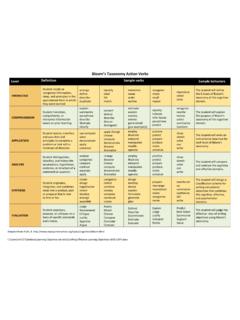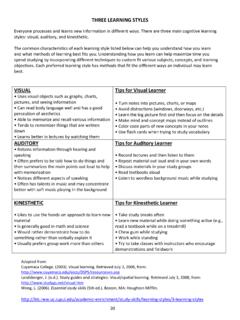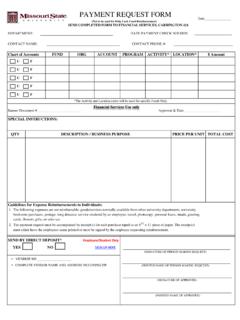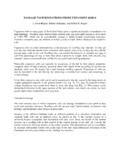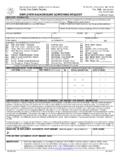Transcription of Creating a Personal Financial Plan - Missouri State University
1 Creating a Personal Financial plan Overview Setting goals are important and often used to measure success. However, simply setting goals does not ensure you will someday accomplish them. Achieving goals requires establishing a plan . Planning is important to ensure a direction for your day-to-day actions. Being deliberate about establishing a plan can help guide the decisions you make to aid you in reaching your goals. The further your goals are from today, the more important it is to have a plan to ensure your success in reaching those goals. Think about it. You may not consult a map for a trip to the store across town, but you will probably want directions, or a plan , for a spring break trip to California. When it comes to Personal Financial goals, many can be long term. Paying off student loans, a new car, or a mortgage on a home does not happen in a month or even a year.
2 Retirement is an even longer-term goal. When it comes to Financial matters, planning can be of paramount importance. Creating a Personal Financial plan has six basic steps: 1. Determine your current Financial situation 2. Develop your Financial goals 3. Identify alternative courses of action 4. Evaluate alternatives 5. Create and implement your Financial action plan 6. Review and revise the Financial plan It is never too early to begin planning. In fact, the earlier you begin planning for your Financial future, the sooner you will reach your goals. Because of the nature of interest and compounding that can be associated with investing, starting early can have great benefits. The longer your investments have to grow, the greater their growth will be. For instance, if you invest $5,000 today and receive a 6% annual compounding interest rate, your investment will grow to approximately $10,000 within 12 years.
3 Within 24 years, the $5,000 investment would grow to $20,000 and within 36 years to $40,000. While a $5,000 investment at that rate made at age 48 would only grow to $10,000 by age 60, the same investment made at age 24 would grow to four times that value by the same age. As you can see, it can certainly be advantageous to get started planning for your Financial future as early as possible. The worksheets on the following pages will help you navigate the six steps outlined above for Creating your Personal Financial plan . Remember, your Financial goals won t be realized just by setting them. You have to be intentional about Creating a plan and diligent in executing it. After all, directions to your spring break destination won t do much good unless you follow them. Step #1: Determine Your Current Financial Situation Before you can begin setting goals and developing strategies to achieve them, it is important to understand where you are now.
4 The first step in Creating your Personal Financial plan is determining your current Financial situation. Having a thorough understanding of your current Financial situation will help you to formulate realistic and well-informed goals. Taking a detailed look at your situation may also help you identify specific changes you could make to change your situation and help you achieve the goals you will create later in the planning process. To gain insight into your current situation, it can be helpful to determine your current net worth. To calculate your net worth, you will need to total your current liabilities and subtract them from your total current assets. Assets are simply what you own that has value. These include: cash and cash equivalents, such as physical cash on hand, checking accounts, or savings accounts; Personal property, such as equity in a home, other real estate owned, or a car; and invested assets, such as stocks, bonds, or pensions.
5 Liabilities include value of what you owe including current bills and outstanding debt. Utilizing the charts below, calculate your current net worth. Total Assets Total Liabilities Net Worth CDsTotal of All AssetsAssets (What I Own)Cash & Cash Equivalents Cash on Hand Checki ng Account Savi ngs AccountTotal Real & Personal Property Li fe Insurance Val ue Savi ngs Bonds Money owed to meTotal Cash EquivalentsPersonal Property Esti mate Equi ty i n Home Other Real Estate Househol d Furni shi ngs Speci fi c Items of Val ue Automobi l es Other Personal Property 401(k)s and si mi l ar pl ansTotal Invested AssetsInvested Assets Stocks & Mutual Funds Bonds Government Securi ti es IRAs Pensi onsTotal Outstanding Debt Home Mortgage bal anceLiabilities (What I Owe)
6 Charge Accounts Credi t Card Bal ances Uti l i ti es Rent Insurance Premi ums Taxes Other Bi l l sTotal Current BillsCurrent BillsOutstanding Debt Other Mortgages Automobi l e Loan bal ance Student Loan Bal ance Al l Other Loan Bal ancesTotal of All LiabilitiesStep #2: Develop Your Financial Goals Once you have evaluated your current Financial situation, you are ready to move forward in the Financial planning process. The second step is developing your Financial goals. Setting goals will give you a direction for your plan and a destination toward which you want to head. When Creating Financial goals, you will want to consider obvious objectives such as monthly savings or retirement investments. However, also consider other goals you have which may not immediately stick-out as Financial ones.
7 The goal of backpacking through Europe upon graduation may not seem like a Financial goal on its face. But, when considering the cost of a three week European vacation, you may want to think about adding this goal to your Personal Financial plan . Do you think you may need a new computer within the next couple of years? Maybe add purchasing a new computer in two years to your list of goals. Anticipating future expenditures you would like to make and incorporating them into your Financial plan can help you put yourself in a position to afford them as they arise without having to make sacrifices elsewhere in your budget. As you develop your Financial goals, recall the first tip from Chapter One which discussed setting your goals. Your goals should be SMART, that is specific, measurable, attainable, realistic, and time-based. You should also develop short-term, intermediate, and long-term goals.
8 Developing each of these types of goals will allow you to achieve successes early in the plan while also keeping your eye toward the future. Short-term or intermediate goals may also serve as stepping stones to reach long-term goals. For instance, a short term goal of saving $200 a month may help you accumulate funds for the down payment on a home. An intermediate goal of paying off student loan debt a year ahead of schedule may help you free-up monthly income that could instead be used to make a car payment. When developing your goals, be sure to differentiate between necessities and wants. Establish priorities. Consider the net worth you calculated in step one and how realistically your goals align with your current Financial situation. Considering the points in this section, reexamine the Financial goals you set in Chapter One.
9 Using the worksheet on the following page, add to, amend or re-record those goals for incorporation into your Personal Financial plan . Be sure to prioritize your Financial goals in order of their importance to assist you later in the planning process. Once you have set your goals, refer to your target date and the duration of your goals costs to determine a monthly cost that will be associated with working toward your goal. Financial plan Goals Worksheet Short-Term Goals (Less than 1 year) Priority Goal Total Cost Duration Monthly Cost Target Date Intermediate Goals (1-10 years) Priority Goal Total Cost Duration Monthly Cost Target Date Long-Term Goals (Over 10 years) Priority Goal Total Cost Duration Monthly Cost Target Date Step #3: Identify Alternative Courses of Action So far in the planning process you have evaluated your current Financial situation and established some SMART short-term, intermediate, and long-term goals.
10 But your goals won t be accomplished simply by Creating them. You will have to devise strategies to help you bridge the gap from where you are today to where you would like to be. Just as there is more than one way to get from campus to your favorite ice cream shop in town, there is more than one route you can take to achieve Financial success as you have defined it. The next step of the Financial planning process involves identifying alternative courses of action that can lead you to your goals. Let s suppose you re planning to study abroad next year. You d like to be able to make the most of your experience while overseas and have enough Financial resources to travel while abroad. You have decided you would like to have saved $4,000 by the time you depart in 15 months, specifically for your travel endeavors. Maybe your Financial situation is such that, so long as it persists in its current form, you will be financially prepared for your travel adventures while abroad.

